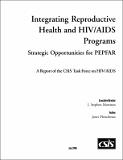| dc.description.abstract | Twenty-five years into the AIDS epidemic and halfway through the initial five-year
phase of the U.S. President’s Emergency Plan for AIDS Relief (PEPFAR),1 there is
increasing international consensus, including within the U.S. government, about the
imperative to target women and girls. With women now constituting 60 percent of those
living with HIV/AIDS in sub-Saharan Africa, and young women accounting for threequarters
of 15- to 24-year olds living with the virus, this is an urgent agenda.2 PEPFAR is
well positioned to build on this consensus and make integration of reproductive health
(RH), family planning (FP), and HIV/AIDS services a major new priority.3 RH-HIV
integration presents important opportunities for PEPFAR to expand its impact and to improve its prospects for achieving its prevention, care, and treatment goals. It is also a
new way of thinking in larger terms about how to enhance the sustainability of PEPFAR
and to overcome the barriers to broader access for HIV/AIDS services. | en_US |

